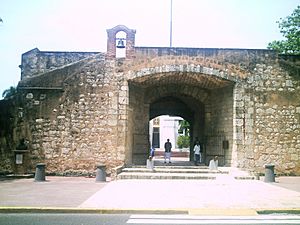Siege of Santo Domingo (1655) facts for kids
Quick facts for kids Siege of Santo Domingo |
|||||||
|---|---|---|---|---|---|---|---|
| Part of the Anglo-Spanish War (1654–60) | |||||||
 Puerta del Conde originally named Fort San Genaro. |
|||||||
|
|||||||
| Belligerents | |||||||
| Commanders and leaders | |||||||
| Strength | |||||||
|
2,400 soldiers:
|
13,120 soldiers:
|
||||||
| Casualties and losses | |||||||
| 30 dead | ~600 dead | ||||||
The Siege of Santo Domingo was a battle that happened in 1655. It took place in the Spanish colony of Santo Domingo, which is now part of the Dominican Republic. A large English army and navy tried to capture the city from the Spanish.
The Spanish forces, led by Governor Don Bernardino Meneses y Bracamonte, Count of Peñalba, had about 2,400 soldiers. They successfully defended the city. The English forces were much larger, with over 13,000 soldiers and 34 ships. They were led by General Robert Venables and Admiral Sir William Penn. The siege lasted for about a week, from April 23 to April 30, 1655.
Contents
Why Did the English Attack?
In 1655, England was ruled by the Commonwealth of England, led by Oliver Cromwell. Cromwell decided to start a war with Spain. One reason was religious: many English leaders were puritans, who did not like the Catholic religion of Spain.
Another reason was more practical. England had a very large army after a civil war. Cromwell wanted to keep these soldiers busy and far from home. He also believed that fighting Spain would be easy and profitable. He thought England could capture rich Spanish colonies.
Cromwell planned a big expedition to the Caribbean Sea. This plan was called the "Western Design." General Robert Venables was put in charge of the army. Admiral Sir William Penn led the navy, which had 34 ships.
However, the expedition had problems from the start. The troops were not the best, and they lacked proper equipment and supplies. Cromwell also sent two special "Civil Commissioners" to watch Venables and Penn. This showed he didn't fully trust his commanders. The English hoped to take over Santo Domingo, Cuba, and Puerto Rico.
The Invasion of Santo Domingo
The English fleet faced strong winds and waves, making it hard to land near Santo Domingo. They finally managed to land their 13,000 soldiers on April 13, 1655. However, they landed far from the city, about 30 miles away at the mouth of the Nizao River.
It took the English soldiers four days to march towards the city. They were short on water, food, and military supplies during this long march. When they finally got close to Santo Domingo, they were ambushed. Only 200-300 local Spanish militia attacked them.
Despite being outnumbered, the Spanish militia defeated the English. Spanish records say that about 1,500 British soldiers were killed, wounded, or captured. After this defeat, the English navy tried to bomb the city, but it didn't work. The English ships then sailed away to pick up the remaining soldiers.
What Happened Next?
The English historian N.A.M. Rodger said that the famous reputation of the English "New Model Army" was ruined in just one afternoon. The English forces left Santo Domingo after their failure. They then sailed to Jamaica, which they successfully captured in a short six-day campaign.
General Venables and Admiral Penn were disgraced when they returned to England. They were even put in prison in the Tower of London. Historians believe that the main reason for their failure at Santo Domingo was that Venables and Penn did not work well together. Venables also struggled to gain the trust of his own officers and soldiers.
The Spanish governor, Don Bernardino de Meneses y Bracamonte, was praised for his bravery. The place where the battle happened was named in his honor: Puerta del Conde, which means "The Count's Gate."
There's also a funny story from the invasion. The English soldiers were supposedly scared by the loud noises of crabs on the beach at night! To celebrate their victory, the Spanish created a special gold crab. They paraded it through the streets of Santo Domingo. Sadly, this gold crab was later stolen by a French governor named General Joseph de Barquier.
Images for kids
See also
 In Spanish: Asedio de Santo Domingo (1655) para niños
In Spanish: Asedio de Santo Domingo (1655) para niños


